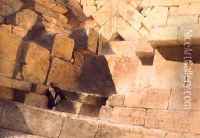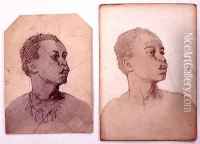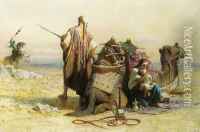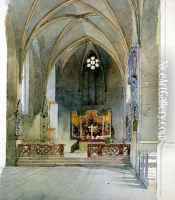Carl Haag Paintings
Carl Haag was a notable German-born British artist, renowned for his watercolor paintings and orientalist scenes. Born on April 20, 1820, in Erlangen, Bavaria, Haag initially embarked on his artistic journey at the Nuremberg Academy of Fine Arts. His talent and dedication to art led him to further his studies and refine his skills across various European cities, including Rome and Venice, where he was deeply influenced by the rich artistic traditions and the vibrant cultures of these regions.
In the early 1840s, Haag moved to England, where he would eventually become a naturalized British citizen. This relocation marked a significant turn in his career as he immersed himself in the British art scene, gaining recognition and becoming a member of the Royal Academy. His early works in England were primarily oil paintings, but he soon developed a profound affinity for watercolors, a medium through which he achieved great acclaim.
Haag is best remembered for his orientalist subjects, a genre that became increasingly popular in the 19th century as Western artists sought to capture and depict the exotic landscapes, peoples, and cultures of the East. His travels to the Middle East, including stops in Egypt, Syria, and Jerusalem, provided ample inspiration for his work. Through his meticulous and vibrant watercolors, Haag was able to convey the luminosity and intricate details of these distant lands, earning him considerable success and a distinguished reputation among collectors and the public alike.
Throughout his career, Carl Haag exhibited a keen eye for detail and an unwavering commitment to realism, attributes that set his work apart from his contemporaries. His paintings not only offered audiences a glimpse into the exotic and unfamiliar but also demonstrated the artist's deep respect and fascination for the cultures he portrayed.
Carl Haag's legacy as an artist endures through his contributions to the orientalist genre and his masterful watercolors. He passed away on January 24, 1915, in Oberwesel, Germany, leaving behind a body of work that continues to be celebrated for its beauty, precision, and insight into the oriental world.

















